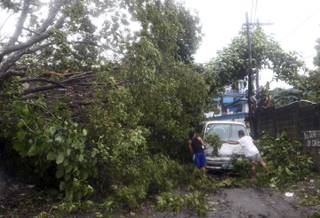
Nelson Salting / AP
Huge waves brought about by powerful typhoon Haiyan hit the shoreline in Legazpi city, Albay province Friday, Nov. 8, 2013 about 520 kilometers ( 325 miles) south of Manila, Philippines. Typhoon Haiyan, one of the most powerful typhoons ever recorded slammed into the Philippines on Friday, setting off landslides, knocking out power in one entire province and cutting communications in the country’s central region of island provinces.
Published Friday, Nov. 8, 2013 | 7:50 a.m.
Updated Friday, Nov. 8, 2013 | 10:05 p.m.
MANILA, Philippines — One of the strongest storms on record has killed more than 100 people and injured another 100 in the central Philippines before sweeping west toward Vietnam on Saturday, still packing destructive winds capable of blowing away houses and uprooting trees.
Capt. John Andrews, deputy director general of the Civil Aviation Authority of the Philippines, said he had received "reliable information" from his staff describing the death and destruction Typhoon Haiyan wrecked in Tacloban city on Leyte Island, about 580 kilometers (360 miles) southwest of Manila, where the storm made landfall Friday.
He told The Associated Press that more than 100 bodies were lying in the streets and another 100 were injured.
He said messages from civil aviation authorities in Tacloban to the capital, Manila, had to be relayed through another airport in the central Philippines once every five hours to conserve radio batteries.
The Philippine television station GMA reported its news team saw 11 bodies, including that of a child, washed ashore Friday and 20 more bodies at a pier in Tacloban hours after the typhoon ripped through the coastal city.
At least 20 more bodies were taken to a church in nearby Palo town that was used as an evacuation center but had to be abandoned when its roofs were blown away, the TV network reported. TV images showed howling winds peeling off tin roof sheets during heavy rain.
Ferocious winds felled large branches and snapped coconut trees. A man was shown carrying the body of his 6-year-old daughter who drowned, and another image showed vehicles piled up in debris.
Nearly 800,000 people were forced to flee their homes and damage was believed to be extensive.
Weather officials said Haiyan had sustained winds of 235 kph (147 mph) with gusts of 275 kph (170 mph) when it made landfall. By those measurements, Haiyan would be comparable to a strong Category 4 hurricane in the U.S., nearly in the top category, a 5.
Hurricanes, cyclones and typhoons are the same thing. They are just called different names in different parts of the world.
The typhoon's sustained winds weakened Saturday to 175 kph (109 mph) with gusts of up to 210 kph (131 mph) as it blew farther away from the Philippines toward Vietnam.
In Vietnam, state media reported that several central provinces began evacuating some 300,000 people from high risk areas. The typhoon was expected to make landfall in the central region early Sunday morning.
Because of cut-off communications in the Philippines, it was impossible to know the full extent of casualties and damage. Officially, four people were listed as dead as of Saturday morning, before the latest information from Tacloban came in.
Southern Leyte Gov. Roger Mercado said the typhoon ripped roofs off houses and triggered landslides that blocked roads.
The dense clouds and heavy rains made the day seem almost as dark as night, he said.
"When you're faced with such a scenario, you can only pray, and pray and pray," Mercado told The Associated Press by telephone, adding that mayors in the province had not called in to report any major damage.
"I hope that means they were spared and not the other way around," he said. "My worst fear is there will be massive loss of lives and property."
Eduardo del Rosario, head of the disaster response agency, said the speed at which the typhoon sliced through the central islands — 40 kph (25 mph) — helped prevent its 600-kilometer (375-mile) band of rain clouds from dumping enough of their load to overflow waterways. Flooding from heavy rains is often the main cause of deaths from typhoons.
"It has helped that the typhoon blew very fast in terms of preventing lots of casualties," regional military commander Lt. Gen. Roy Deveraturda said. He said the massive evacuation of villagers before the storm also saved many lives.


Join the Discussion:
Check this out for a full explanation of our conversion to the LiveFyre commenting system and instructions on how to sign up for an account.
Full comments policy